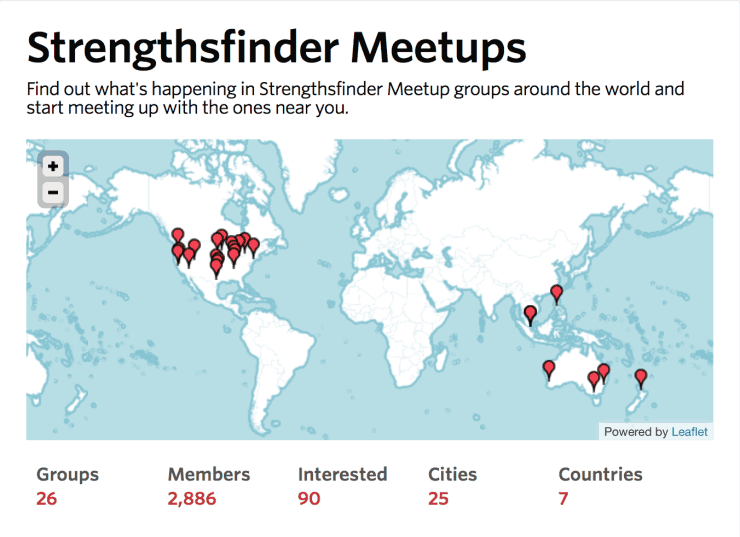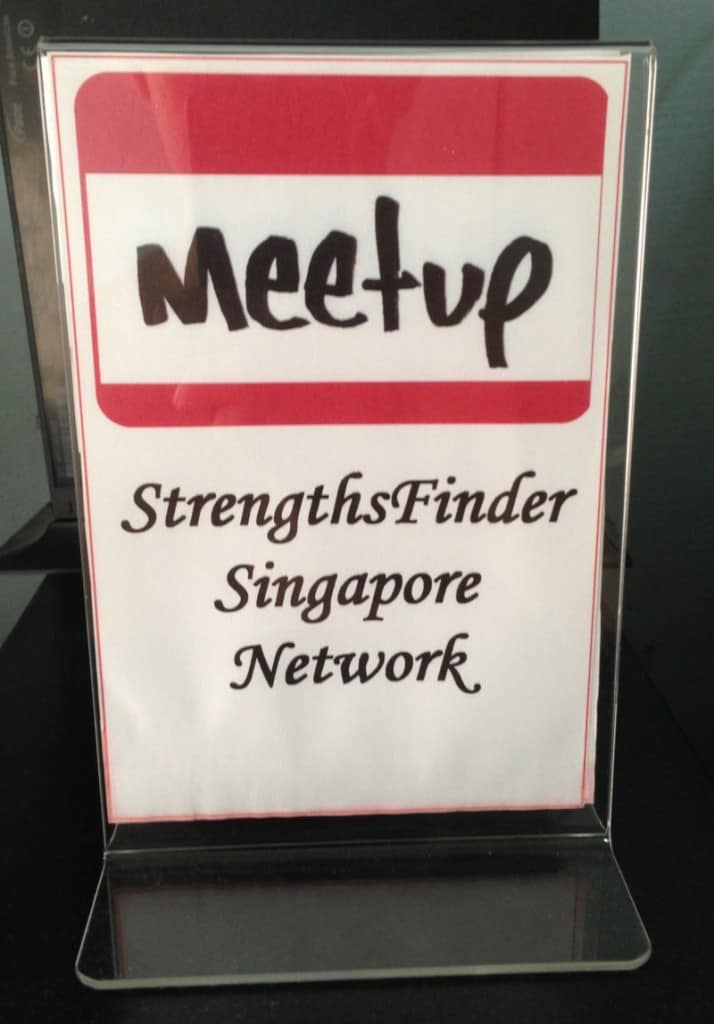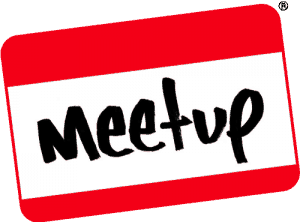
As of 10 Jul 2015, we have 26 StrengthsFinder Meetup Groups with over 2,800 members globally. As the Strengths Movement gains greater momentum, more and more people would like to be part of a StrengthsFinder community. But what if there isn’t a StrengthsFinder Group in your locality? Consider starting one in your own neighbourhood. You don’t need much resources to do so, just a deep passion for strengths and the willingness to propagate the Strengths Movement in your own community.
About the StrengthsFinder Singapore Network
I founded the StrengthsFinder Singapore Network on 22 Jan 2014. After about 1.5 years and 20 meetup sessions, we now have 279 members and a thriving community that supports each other. The Network now has 3 types of meetup sessions (Basic, Advance & Talent Showcase), meets up at least once a month, and has an active chat group with a very family-like atmosphere.
I started the meetup with minimal resources (just the cost for the meetup platform of about 5USD monthly) and no sponsors, and this article is about how to go about doing it.
P.S. If you are interested in my personal Strengths Journey, and my sharing on StrengthsFinder and starting a meetup, you may wish to listen to the interviews I did with Gallup Called to Coach, Singapore Edition and Unleash Strength’s Theme Addict Podcast. You can also read about my journey in starting a meetup group in this article “Journey of Building a Strengths Community”
Begin with Personal Clarity
We must first create clarity for our intent and purpose for creating a meetup group. Here are some questions to consider:
- What’s your story? Why do you want to start a StrengthsFinder Meetup Group?
Start by asking yourself, what’s your motivation for starting a meetup group? Identify and script down your own Strengths Journey and what StrengthsFinder has done for you. How does starting a meetup group fit into your journey? - What do you define as “Success” for your meetup group? What will it look like when you have arrived?
Habit 2 of the 7 Habits of Highly Effective People is to “Begin with the end in mind”. What is the definition of success of your group? What will you see, hear or feel when you arrive?For me, I know when my meetup group is successful when people’s lives are impacted as they learn and discover about their strengths. They will be energised, and motivated to come back. Because of the positive impact of their lives, they are enthusiastic about bringing their friends to the group and sharing about the StrengthsFinder tool. Beyond the usual meetup sessions that we have, members of the group will get to know each other on a deeper level and become more like friends than acquaintances. There will be a familiarity and the experience will be like being part of one big family. - How will your members benefit from it?
The first question that every person has, whether it is verbally articulated, is this : “What’s in it for me?”
Clearly define the benefits that members will get from the meetup group, and who this meetup is for.This is what I wrote for the “About us” section for the StrengthsFinder Singapore Network:“Network and develop your talents with fellow StrengthsFinder enthusiasts in the Sunny Singapore. Gain a deeper appreciation for your own strengths. Grow stronger personally and professionally learning strengths-based strategies and techniques. Work smarter maximizing your talents by exchanging strengths tools and best practices. Let’s grow from talents to strengths, potential to performance!”
- How will you benefit from it?
The next question people will have is “What’s in it for you?” People may sometimes become suspicious as to whether they have walked into a sales pitch. Clarifying your own motivations for starting the group answers that question and helps people to be more relaxed. It also helps to create an atmosphere of trust and authenticity.Be careful to share the truth rather than a reason that’s made up. Remember:You can fool some of the people all of the time,
or all of the people some of the time,
but you can never fool all of the people all of the time.I share with my members that the reason I created the meetup group is because I didn’t want others to do the same thing that I did and waste a wonderful opportunity of learning about themselves and developing themselves to be the best version of themselves. At the same time, it also provided me with the opportunity to really see the talent themes play out during out sessions. In as much as they are learning from me about StrengthsFinder, I’m learning plenty from them. And after all, this fits perfectly into my Top 5 Talent themes: Empathy, individualization, Developer, Strategic, Learner.
- How frequently will the group meet?
Once you have clarified your intent and objectives, what success looks like, the benefits for your members and yourself, it is now easier to identify how much time and effort you would like to invest into this group. Remember that whatever you decide needs to be sustainable, both financially and in terms of time.I decided to start off with just one session a month. It is better to start small and grow the group if you have additional capacity than to burn yourself out and have the group die out. - Which day will the group meet? Be consistent.
When I started the group, I intended to do it on an ad-hoc basis. It could be any Saturday or Sunday of the month depending on my own availability. But I quickly learnt from my members that having a fixed date and time of the month for the meetup helps the members to remember the date more easily.And so I settled for the last Sunday of every month for my meetup. The advantage of doing this is that the meetup platform has a function for you to create recurring meetups so I minimise the amount of time I spend administratively on creating them. - Where will the group meet? Be consistent
Deciding on a venue can be challenging for a start. But you eventually have to stabilise your venues and have just 1-3 key venues which you can use. It would be great if your venue is fixed at one location, but having alternatives in case your preferred venue is unavailable can be extremely useful! - Will you charge? How much, and how?
It is important for the meetup for be financial viable for you. You may have to seed the starting of the group out of your own pocket, but in the long run, this shouldn’t be something that bleeds you dry.So you have to decide on how you intend to host the meetup groups and whether you would like to charge for it. There are some pros and cons to charging for a meetup. Charging for a meetup automatically creates a filter where you sort out between the seriously interested vs the mildly curious. For me I’ve started off by not charging for the meetup.If you should choose to charge, the meetup platform provides you with two options: Membership Dues and Event Fees.Membership Dues allows you to collect an annual fee for members to be part of the group. When starting a new group, I prefer to not set membership dues as it would stunt the growth of the meetup group. And also reduces the likelihood of having the curious join the group and resulting in missing the opportunity to really share about strengths to that group of people.Event fees allows you to collect a one-time fee for each meetup session you hold. You can choose to collect that via the meetup platform, and the system can be set in such a way that a person’s RSVP is only confirmed after he/she has paid. Alternatively, if you do not wish to pay for the transaction fees, you can do this manually during the meetup. The advantage of charging for a meetup is that you reduce the likelihood of no-shows, the disadvantage is that you probably have much fewer sign-ups unless you are very established.
Creating Your Meetup Group
Create Content
Once you have gain clarity for your meetup group, you can get on www.meetup.com to create your meetup group. Follow the instructions provided by meetup, and it’s pretty self-explanatory. Remember to choose “StrengthsFinder” as one of the topics so that you show up in the list of StrengthsFinder Meetups.
Start off with creating the description for your about page. It is the first thing that people will be exposed to, and as most people’s attention spans are short, make your description succinct and highlight what the group is about.
Pages – You can create different pages in your meetup group. Most meetup groups do not use this fully, and you can actually create a pretty good site to share some basic information. I’ve created an about page (This is your main page), one for interesting articles, and others for information sharing. Get creative, and if you don’t have your own website, you can maximize the features available here.
Discussion Boards – These discussion boards can be useful if you have an interactive community. I’ve tried to create conversations here, but found that it doesn’t really work well for the group. It is basically a repository for emails I send out (There’s an option to post the emails you send out in the discussion board), and I use Facebook to facilitate sharing and discussion.
Announce your meetup
Once you are done with your meetup, you can announce it. When you do this, meetup will send an email to people who have indicated interest in the topics that you have selected. This helps to attract people to join your meetup group.
Inviting your friends
Once you have announced your meetup group, make a conscious effort to invite your friends to join your meetup group. Sharing it on Facebook and other social media is fine, but I’ve found that personal invitations work a lot better. Share with those who have expressed interest in StrengthsFinder and get them to join you for your meetup. Be honest and let them know that you need support. Aim to get about 20-30 members signed up for your meetup group as a primer. People look for social proof, so having a nice cozy group to start off will help encourage others to join. Of coz, thank them and let them know when you plan to hold your first meetup.
Organising Your First Meetup Session
Choosing a location
Location is one of the most important things for the meetup. It will be determined by how you would like to run your meetup. For a start, I recommend looking for a cafe that allows you to make reservations and also be quiet enough that people can hear each other during the discussion. In Singapore, many of the business districts are like ghost-towns during the weekends and are perfect for this purpose.
It is best to physically scout the locations to see if the environment is suitable, and if they provide you with suitable tables for your sessions.
Eventually, as you grow, you may wish to find some meeting rooms to accommodate larger groups of people.
Do we need a projector?
Depending on the format of your meetup, you may wish to have visual-audio facilities. As groups typically start small, start your initial sessions at cafes, and move on to meeting rooms which the necessary equipment. By then, people would have started to appreciate the value of the meetups and be more willing to contribute toward the cost of the meetup. After all, even when a cafe is used, everyone typically buys at least a drink to use the venue.
Create a small table stand

If you do not have a meeting room or a private area, you will need some way for people to identify you. I create a small table stand which I place on the table of the cafe so that members can identify me. Create one that is easily identifiable, and it will save you a lot of pain.
Meetup Duration
Decide on the duration of your meetup. I find that 2 hours is a good span of time for a meetup. It isn’t too intimidating for new members, and provides with ample time to create value for the people. I also tell them that I’ll be around for the next 30mins if there are of the who would like to hang around to chat.
Be upfront about costs
Be upfront about any expectation for expenses. If you are using meetup.com platform for membership dues or event fees, that becomes quite straight forward. If you expect people to be spending money to buy their own beverages for the venue, state that upfront.
As my meetup group grow, I started to use a meeting room which has some charges. I share the cost upfront and let them know that they would need to contribute to the cost. I let them know that if they have found value during the session that they could contribute a little more, and that I would continue to use the room for as long as it remains financially viable for me (i.e. break even). I put a cashbox at the end of the room, and let them know to contribute whatever amount they feel is appropriate.
Structural Outline of a Meetup
It is useful to have a structure in mind so that you know how to pace yourself. Here is the outline of a typical StrengthsFinder session:
- Wait for Late Arrivals (5min)
- Welcome & Self-Introduction by self and members (5-10min) – Depending on the turn-out, this can take quite some time.
- Introduction to StrengthsFinder and the Meetup Group (10min)
- StrengthsFinder Activities (90 min)
- Wrap up & Sharing of Personal Insights (15min)
- Completion of Feedback Form (5min)
Pre-Meeting Preparation
Creating Your Meetup
First thing that you need to do is to create your meetup on the platform. Some useful information to include in your meetup description includes:
- Summary Paragraph to get attention
- Agenda, Benefits, Anticipated Outcomes
- Costs, if Any
- What to bring
- Directions to Venue
I set the RSVP period to start 3 weeks before the actual meetup, and ends 1 day before the meetup. This helps me to estimate the number of people coming.
Make use of meetup to ask relevant questions to members when they RSVP. The questions that I ask are:
- What are your StrengthsFinder Top 5 Talent Themes (if you have taken it)?
- Are there any specific topics you would like addressed at the session?
When you have the information, you now know what are the objectives of those attending, and you can identify ways to make it more relevant to your audience.
Creating presence through social media
Once you have created your meetup, you need to let more people know about it. Social media is a wonderful place to help get the word out. Post it on your own Timeline, post it in StrengthsFinder Facebook Groups, Post it on Twitter…. you get the idea.
Also take time to personally invite friends and people whom you know would be interested to RSVP for the event. That personal touch can make a big difference in the attendance.
Other Preparation
I will also prepare the following for the meetup sessions:
- Attendance Sheet (Contains Name, their Top 5, a column for their contact number, their email, and their signature)
The attendance sheet is very useful for getting their information and tracking attendance especially since I may not remember all of their names from just one session. I highlight that the contact numbers are for those who would like to be added to a special whatsapp chat group that is reserved specially for those who have attended the meetups, and the email addresses are for adding people into my Facebook Group where I share information, articles, etc. - Strengths Team Grid of those who RSVPed
The Strengths Grid is interesting information to have, and helps me to prepare for how to interact with the members. Sometimes, I’ll flash the information up on the screen just to generate some interest. The most common theme in my meetup group is Learner. - Worksheets / Materials for the Meetup
Having something for the members to bring back creates more value, and some reference materials that they can keep. I also keep a number of copies of the StrengthsFinder quick reference guide which is extremely useful for members who have yet to take the StrengthsFinder assessment before turning up. - Feedback Form
Not everyone will be willing to provide their feedback in public, so a feedback form provides a non-threatening way to obtain feedback from everyone. It can also be a huge time-saver comparing to going round the table asking for everyone’s feedback. Make sure that you review the feedback to learn about what works for the members, and how to tweak the sessions to make them even better.
During Meetup
Setup
Arrive at least 15-20 mins earlier to set up your venue. You may find that you face some technical difficulties in getting the equipment set-up and would be glad that you arrived earlier to get everyone set up.
Place the small table stand or a notice at a visible location so that people can find you easily.
Welcome
You will have some people who arrive earlier, and if these people are new to the meetup group be sure to welcome them warmly! Remember that a person’s first impression is formed in the first few seconds, and will also set the tone for these members. Always thank your members for being early, this will help to encourage the behaviour of people being on time.
Invite the members to sign the attendance sheet, and let them know that it is how you track who has turned up and also identify the no-shows in your group.
If you are still busy with setting up, be sure to acknowledge them, and excuse yourself to complete the setting up.
Introduction
If all your members have arrived, do start the session on time, otherwise, it is polite to inform those present that we will wait for another 5 mins for some late comers, and start when the time is up. This is to ensure that you do not penalize those who made an effort to be on time, and if you are paying for the use of the venue, it is prudent use of resources.
Because of my talent themes, I like to get to know my members before I start. I find that it helps the people get more comfortable and therefore be more willing to speak up. I typically get them to share what their top 5 are, what they are currently doing, and what they hope to get out of the session.
Once we get to know each other a little, I’ll introduce them to the group, my personal strengths journey, and the reason for the meetup group. This would be an easy task of articulating what you have thought through in the “Being with Personal Clarity” section at the start of this article. State your intentions, objectives and motivations clearly upfront to put people at ease and avoid any second-guessing.
The introduction is an important part of building the community. Make a commitment to be vulnerable and authentic, and it will make others more comfortable in sharing their own unique positions and situations. The more open the group is, the more powerful the insights, and the closer the community spirit. If you want the culture of the community to be trusting, you demonstrate that trust to others first.
At this stage, you may wish to remind everyone about the signing the attendance sheet again (assuming most, if not all, have arrived).
Do strengths based activities
It’s not about you – Let them speak
One thing that I’ve learnt from the feedback I’ve received from my group is this – The less I speak, the more satisfied they are. I started off thinking that I am the subject matter expert and that I needed to be able to share my knowledge with them, so I ended up speaking more than they did. But the session has proven to be so much more powerful when they make their own connections and discoveries through conversations with each other. I now structure my sessions which provide lots of interaction time amongst the members, and what I do is to walk around to facilitate the discussions amongst these small groups. A good measure of this is to ask yourself, what percentage of time was I speaking for the session, and what percentage of time were the members speaking?
Name! Claim! Aim ??
Most of the people will probably come with the intention to learn how to apply their strengths. Yet often time, I’ve found that these people do not have a sufficient level of self-awareness of their own talents to be able to Aim it. I often highlight the Name, Claim, Aim process and share that in our sessions we need to first learn to Name and Claim before we can aim it. That sets the expectations for the group, and often times, some aiming does occur as a result of the discussion. When they get a deeper understanding of themselves, and also how people can be different from them, it causes a change at a subconscious level that will have a ripple effect across all that they do.
I’ve had a friend who had attended many of my sessions tell me that the sessions were getting a bit routine, and he doesn’t really see the impact of how the basic sessions will continue to benefit him. I asked him how the understanding of his talent themes, and the ability to see and appreciate the differences in people affected his work and his relationships. After giving it some thought, he realised that his work and relationships had indeed been improving! Don’t underestimate the power of self-awareness, it is the starting point for powerful change!
Be willing to give first
One thing I’ve struggle is how much do I give out in the sessions? Some of us are in the business and would need this to have a financial return, so you need to decide how all these fit together for you (something that you would have gotten when you completed the “Begin with Personal Clarity” section). I’ve learnt that I have to give it my all, but not give it all away. I will always give my best in all my sessions, but I will not give all my tools, materials and knowledge in the session – there isn’t enough time to do so anyway.
But people can sense when you are being authentic, and will open up to you. Who knows, some of these members may end up becoming your client!
Cater to new explorers – people who have not taken the StrengthsFinder Assessment
You will typically get a few types of people in your meetup
- Not Taken StrengthsFinder
- Taken StrengthsFinder but done nothing with it
- Taken StrengthsFinder and tried to do something on their own with it
- Taken StrengthsFinder and attending a relevant workshop / coaching
You need to be able to address all groups of people, and be able to create value for them. Otherwise, they will not find that their time has been well used, and will not come back.
Prepare the StrengthsFinder Quick Reference Card for those who have not taken the assessment. You need to give them some handle for your activities, or they will become totally lost. I’ve found that giving them the quick reference card provide them with something that they can bring back (i.e. value!) and also perks their curiosity so that they will take the assessment.
Sharing of Insights & Learning Points
At the end of your session, all each person to share their learning points or key takeaways. This forces people to think about what value they have received out of the time they had spent with you, and also serves to lock in those learning. It ends off the session with people sharing their aha! moments with each other and warps up the session on a positive note.
I personally find that this also give me the opportunity to practice/demonstrate my coaching skills, and help people to dig deeper into the insights they have received. Many of these insights are also valuable to me as a coach, and have found their way into some of the articles I’ve written on my website.
Feedback Time
Cater time for some feedback, especially on the first few sessions. Ask people about
- Whether the day and time is suitable?
- Whether the venue was conducive, and if anyone has suggestions on where else the sessions can be held?
- Which segment was most valuable?
- What could be done better?
If time doesn’t allow, simple use the feedback forms to quickly gather input from the members.
Remind the members to sign the attendance sheet before leaving (in the event of late comers)
Photo Time!
I make it a habit to take a group photo with everyone present at the end of the session. And if you can afford the time, do take photos of the interactions amongst the group members during the session itself. It creates a nice journal of what has transpired during the session.
Informal after Session Chit-Chat
After the session has ended, there may be a few people who will stay back to ask you some personal questions. This is the time to really know your members, and to serve them meaningfully. Sometimes, we even end up having a nice dinner together to get to know each other better.
Post-meetup
After the meetup, I will collate the feedback, and send a follow-up email to the group. This provides a summary of what we have done, what is the feedback received (so people know you are actually doing something about the feedback they provided), and what’s coming up next. This can sometimes help generate greater interest amongst those who had signed up for the meetup group, but have not found sufficient motivation to actually attend a meetup session.
I will also post the group photo of our meetup session on social media, and tag the group members (if possible), to share what we had done. This can get the word out, and get people curious enough to attend future sessions.
Growing and Sustaining Your Meetup Group
Manage your own expectations
Rome wasn’t built in a day.
Remember that building a community takes time. My meetup group was growing at a rate of 3 new members per week, and I wondered if that was too slow a growth. But having a steady growth is a healthy sign. What kind of expectations are you having of yourself? Is it realistic?
Stick to the frequency that you have decided beforehand, be consistent, and you may be surprised by just how the group grows.
Listen to your members – Feedback, Feedback, Feedback
Remember that feedback from you collected? Make full use of it! Look at what your members are saying, experiment with some changes, and see how that impacts the feedback for future sessions. It will take some experimenting, but you will eventually find that sweet spot for group.
Share and invite your friends
Continue to share with friends about what you are doing. Invite them to join you, and also ask them if they know of any friends who may be interested to tag along.
Create opportunities to contribute
Create the space for your members to contribute to the group. Doing so will help create a greater sense of community and ownership. When the SFSN turned 1 year old, I created a new series of sessions called “Talent Showcase”. The intent is to invite members of the meetup group to share on their specific areas of expertise. The sessions have been well received thus far, and it create additional value for all the members.
Social Media and WhatsApp
Social Media and whatsapp are two very useful tools to build the community spirit. When people attend the meetup group, I collect their emails and phone numbers and add them to our Facebook group and whatsapp chat group. I make informal announcements through the two channels, and we have small discussions every now and then on strengths or other interesting topics. Some people do leave the chat group because they don’t find it suitable, and that’s fine. Overtime, you will discover who your loyal members are, and who you would want to invest more of your resources into.
Consistency of Location
Avoid changing venues too often. Having just 2-3 regular venues will help make it easier for people to attend. Always be clear about where the session is held, and keep reminding people. I’ve had a few cases where some of our regular members went to a wrong venue for the meetup.
Build a team
Build a team of people who can help you run your meetup group if possible. This has proved rather challenging for me to find suitable help, but I’m getting some interest from a few Gallup Certified Strengths Coaches who may be able to help me anchor some sessions. It takes time and effort to build a team, so choose wisely, and make sure they are people who are staying for the long haul.
Encourage referrals, members to bring friends
Think of ways to encourage members to bring their friends for future sessions. One way is to provide incentives for those who bring friends. The other is just to ask and challenge them to bring friends. If they have gotten value from the meetup sessions, its not difficult for them to introduce others to the group.
That’s pretty much it! If you have any comments or questions, please write it in the comment box below (to prevent spam, it needs to be approved before it is displayed). I hope you found it a useful guide in creating your own meetup group and to bring Strengths-Based development to your community!
Get more information about StrengthsFinder by visiting http://gallupstrengthscenter.com




